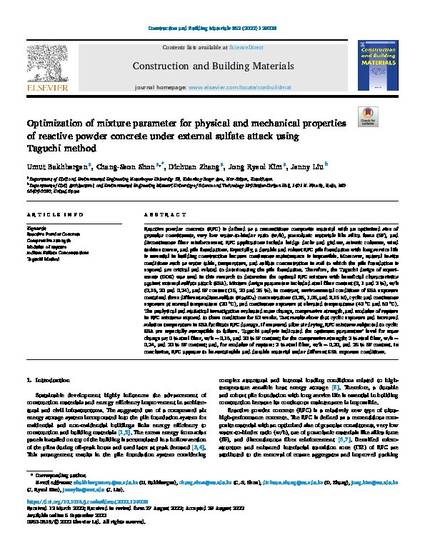
Reactive powder concrete (RPC) is defined as a cementitious composite material with an optimized size of granular constituents, very low water-to-binder ratio (w/b), pozzolanic materials like silica fume (SF), and discontinuous fiber reinforcement. RPC applications include bridge decks and girders, seismic columns, wind turbine towers, and pile foundations. Especially, a durable and robust RPC pile foundation with long service life is essential in building construction because continuous maintenance is impossible. Moreover, natural in-situ conditions such as water table, temperature, and sulfate concentration in soil to which the pile foundation is exposed are critical and related to deteriorating the pile foundation. Therefore, the Taguchi design of experiments (DOE) was used in this research to determine the optimal RPC mixture with beneficial characteristics against external sulfate attack (ESA). Mixture design parameters included steel fiber content (0, 1 and 2 %), w/b (0.16, 20 and 0.24), and SF content (15, 20 and 25 %). In contrast, environmental conditions of ESA exposure contained three different sodium sulfate (Na2SO4) concentrations (0.35, 1.05, and 3.15 M), cyclic and continuous exposure at normal temperature (20 °C), and continuous exposure at elevated temperatures (40 °C and 60 °C). The analytical and statistical investigation evaluated mass change, compressive strength, and modulus of rupture in RPC mixtures exposed to these conditions for 52 weeks. Test results show that cyclic exposure and increased solution temperature in ESA facilitate RPC damage. If measured after air drying, RPC mixtures subjected to cyclic ESA are especially susceptible to failure. Taguchi analysis indicated the optimum parameters' level for mass change as: 0 % steel fiber, w/b = 0.16, and 20 % SF content; for the compressive strength: 2 % steel fiber, w/b = 0.24, and 20 % SF content; and, for modulus of rupture: 2 % steel fiber, w/b = 0.20, and 25 % SF content. In conclusion, RPC appears to be sustainable and durable material under different ESA exposure conditions.
- Compressive strength,
- Modulus of rupture,
- Reactive Powder Concrete,
- sodium Sulfate Concentrations,
- Taguchi Method
Available at: http://works.bepress.com/jenny-juanyu-liu/56/

Nazarbayev University, Grant 021220FD2151